While some disease-causing microbes and viruses have well-described life histories and pathologies, many non-symptom-inducing viruses and microbes have remained unnamed and uninvestigated. However, recent technological advances for DNA sequencing have enabled researchers to detect previously unknown viruses in environmental samples. One group of double-stranded RNA viruses, endornaviruses, has received scant research attention and was only formally described in the 1990s. While their biology and host effects are largely unknown, several unique properties suggest they have a very interesting evolutionary history that merits further investigation. Plants, fungi, and oomycetes are all endornavirus hosts and transmission is assumed to be strictly vertical. In this study led by CIDD Professor Marilyn Roossinck, 11 sequenced endornaviruses were studied using phylogenetic and conserved domain analyses. Several important domains, including a methyltransferase (MeTr) and a helicase, were highly divergent from other sequenced viruses and from each other, and did not cluster based on host association. In addition, most of the endornaviruses contained divergent glycosyltransferase domains, which are unusual in RNA viruses. Improved sequencing and analytical techniques will guide future work on the evolution, biology, and host interactions of viruses in this interesting and largely undescribed virus family.
Synopsis written by Lori Shapiro.
Written By: Roossinck MJ, Sabanadzovic S, Okada R, & Valverde RA
Paper Url: http://vir.sgmjournals.org/content/92/11/2674.abstract
Journal: 2674-2678
Journal Reference: 2674-2678
Paper Id: 10.1099/vir.0.034702-0
